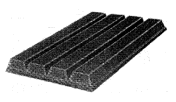Shape of the chocolate bar ‘Kit Kat 4 fingers’, Mondelez UK Holdings & Services Ltd vs EUIPO – Société des produits Nestlé, EGC T-112/13
EUIPO must re-examine whether the three-dimensional shape corresponding to the product ‘Kit Kat 4 fingers’ may be maintained as an EU trade mark. According to the General Court distinctive character acquired through use of the mark must be shown in all the Member States concerned.
In 2002, Nestlé applied to EUIPO (European Union Intellectual Property Office) for registration as an EU trade mark of the following three-dimensional mark, which corresponds to the product ‘KitKat 4 fingers’ marketed by Nestlé:

In 2006, EUIPO agreed to register that mark in respect of the following goods: ‘Sweets, bakery products, pastries, biscuits, cakes, waffles’. In 2007, Cadbury Schweppes (now Mondelez UK Holdings & Services) applied to EUIPO for a declaration of invalidity. In 2012, EUIPO dismissed that application, considering that Nestlé’s mark had acquired distinctive character through the use that had been made of it within the EU.
Mondelez claims that the General Court should annul EUIPO’s decision.
By judgment of 15 December 2016, the General Court annuls EUIPO’s decision. First of all, the Court recalls that, if a trade mark has been registered for a category of goods containing several sub-categories, proof that the mark has been put to genuine use in relation to a part of those goods affords protection only for the corresponding sub-category or sub-categories.
The Court holds that none of the evidence taken into consideration by EUIPO establishes use of the mark in respect of bakery products, pastries, cakes and waffles. Consequently, EUIPO erred in law in considering that the product in question could be included in any of the categories of goods concerned.
Next, the Court recalls that (1) a three-dimensional mark may acquire distinctive character through use, even if it is used in conjunction with a word mark or a figurative mark, and (2) in order for distinctive character to be acquired through use, the sign applied for must have come to identify the product concerned as originating from a particular undertaking.
The Court then examines the evidence taken into account by EUIPO, such as the market surveys carried out in 10 Member States, the advertising material, and how long-standing the use of the mark has been. It confirms that that evidence is capable of establishing that, in the eyes of the relevant public, the three-dimensional mark in question is perceived as an indication of the commercial origin of the goods concerned.
As regards Mondelez’s assertion that Nestlé has not proved distinctive character acquired through use of its mark throughout the EU, the Court considers that distinctive character acquired through use of a mark must be demonstrated in the part of the EU where it was devoid of intrinsic distinctive character, namely in the present case, throughout the EU at the date of filing the application for registration on 21 March 2002 (at that time, the EU was composed of 15 Member States). In that regard, it is not sufficient to show that a significant proportion of the relevant public throughout the EU, merging all the Member States and regions, perceives a mark as an indication of the commercial origin of the goods designated by the mark. In the case of a mark which, like Nestlé’s mark, does not have inherent distinctive character throughout the EU, the distinctive character acquired through use of that mark must be shown in all the Member States concerned.
Although it had been established that the contested trade mark had acquired distinctive character through use in 10 countries (Denmark, Germany, Spain, France, Italy, the Netherlands, Austria, Finland, Sweden and the UK), the Court considers that EUIPO could not validly conclude its examination without coming to a conclusion regarding the perception of the mark by the relevant public in, inter alia, Belgium, Ireland, Greece and Portugal and without analysing the evidence adduced in respect of those Member States.
The Court concludes that EUIPO erred in considering that it was not necessary to prove distinctive character acquired through use of a mark in all the Member States concerned. It follows that EUIPO will have to take another decision in which it verifies that, at the date of filing the application for registration, the mark in question had acquired distinctive character through the use that Nestlé had made of it in the 15 Member States concerned in respect of ‘sweets and biscuits’.
Source: curia.europa.eu/jcms/jcms/p1_267520/en/
General Court of the European Union, PRESS RELEASE No 138/16, Luxembourg, 15 December 2016, Judgment in Case T-112/13, Mondelez UK Holdings & Services Ltd v EUIPO – Société des produits Nestlé (Shape of a chocolate bar)
